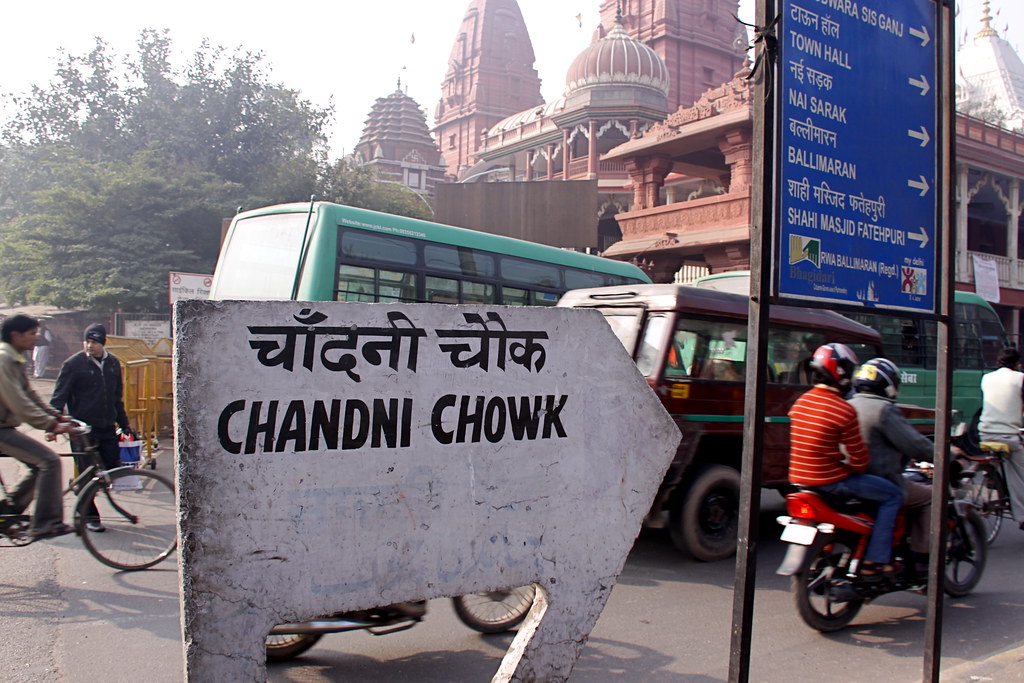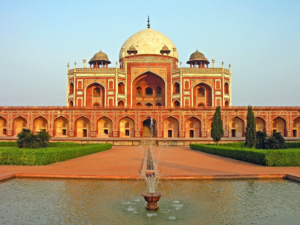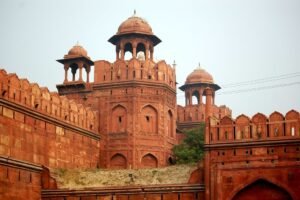When you step into Chandni Chowk, you’re not just entering a bustling market; you’re stepping into history. This iconic marketplace in the heart of Old Delhi has been an integral part of the city’s fabric for centuries. It’s a place where the past and present coexist harmoniously, offering a sensory overload of sights, sounds, and tastes. In this blog, we’ll embark on a journey through Chandni Chowk, exploring its rich history, vibrant culture, popular and lesser-known attractions, and essential shopping tips.
Table of Contents
History Unveiled
Chandni Chowk, translated as “Moonlit Square,” was established in the 17th century by Mughal Emperor Shah Jahan. This grand boulevard was designed as the main street of the Mughal capital, Shahjahanabad (now Old Delhi). Its silver-coated facades, which glistened under the moonlight, inspired its name.
Popular Fact: Chandni Chowk was once adorned with a canal running through its center, reflecting the moon’s glow. Today, that canal has made way for a bustling road.
Less Known Fact: The original design of Chandni Chowk had fountains, gardens, and a square at the center. Over the centuries, it transformed into a bustling market, retaining vestiges of its former grandeur.
Heritage and Architecture
Chandni Chowk is a treasure trove of architectural marvels, reflecting a blend of Mughal, Persian, and Indian styles. Some iconic landmarks include:
- Red Fort: Built by Shah Jahan, the Red Fort stands at one end of Chandni Chowk and is a UNESCO World Heritage Site. It’s a symbol of Mughal grandeur, showcasing intricate marble inlays and delicate filigree work.
- Jama Masjid: India’s largest mosque, Jama Masjid, is a magnificent structure constructed by the same emperor. Its towering minarets and stunning courtyard are awe-inspiring. The climb to the minarets offers a panoramic view of Old Delhi.
- Sis Ganj Gurdwara: This gurdwara is a place of worship for Sikhs and commemorates the martyrdom of Guru Tegh Bahadur, the ninth Sikh guru. The gurdwara’s peaceful ambiance provides a stark contrast to the bustling market outside.
- Paranthe Wali Gali: This narrow lane is famous for its paranthas, and the buildings date back to the Mughal era. It’s a must-visit for food lovers. Parathas are made with various fillings, including potato, paneer, and even rabri (sweet condensed milk).
Popular Fact: Chandni Chowk has been the backdrop for numerous Bollywood films, making it an integral part of Indian cinema history.
Less Known Fact: The famous peacock throne of the Mughal emperors was once stored in a warehouse in Chandni Chowk. Unfortunately, it was later stolen and is now lost to history.
Culinary Delights
Chandni Chowk is a food lover’s paradise. Its narrow lanes are dotted with street food stalls, sweet shops, and iconic restaurants. Some culinary delights you must try include:
- Chaat: Sample the tangy and spicy flavors of Delhi’s famous chaat at various stalls. Natraj’s Dahi Bhalla, Ashok Chaat Corner’s Aloo Tikki, and Annapurna Sweets’ Papdi Chaat are popular choices. The eclectic mix of spices, chutneys, and textures in chaat is a taste sensation.
- Paranthas: The Paranthe Wali Gali is famous for its stuffed paranthas. The variety is staggering, from potato and paneer to even rabri paranthas. Pair these with pickles, chutneys, and a dollop of creamy curd for an authentic experience.
- Karim’s: Known for its Mughlai cuisine, Karim’s is a culinary institution. Try the mutton seekh kebabs and biryanis for a taste of history. The aromatic spices and slow-cooked meat have made Karim’s legendary.
Popular Fact: Chandni Chowk’s food offerings cater to diverse palates, from traditional Indian flavors to global fast food. It’s a place where you can savor street food, Mughlai feasts, and delightful sweets.
Less Known Fact: The origin of the famous jalebi, a sweet spiral made from deep-fried batter and soaked in sugar syrup, can be traced back to Chandni Chowk.
Shopping Extravaganza
Chandni Chowk is renowned for its bustling marketplaces, each with its specialty. Some prominent shopping areas include:
- Kinari Bazaar: Known for its textiles, zari work, and wedding accessories. It’s a treasure trove for brides-to-be looking for stunning fabrics, trims, and embellishments.
- Nai Sarak: A paradise for bookworms, this market is lined with bookstores offering a wide range of titles, from old classics to new releases. Bargain for great deals on textbooks and novels.
- Dariba Kalan: The “Street of the Incomparable Pearl” is famous for its jewelry shops, especially those selling gold, silver, and precious stones. Explore intricate designs and the latest trends in jewelry.
Popular Fact: Chandni Chowk is famous for its bridal shopping. Many brides-to-be visit it for their wedding attire and jewelry, finding stunning pieces at reasonable prices.
Less Known Fact: The narrow streets of Dariba Kalan were designed to ensure shade throughout the day, keeping shoppers cool during hot Delhi summers. This design, typical of Mughal urban planning, reflects the attention to detail in the bazaar’s layout.
Connected Markets
Chandni Chowk’s charm extends to several interconnected markets, each with its unique offerings:
- Chawri Bazaar: Known for its paper, stationery, and wedding card shops. Find beautiful wedding invitations and decorative paper products here.
- Khari Baoli: Asia’s largest spice market, offering a wide range of spices, herbs, dry fruits, and nuts. The market’s vibrant colors and fragrant spices create a unique atmosphere.
- Fatehpuri Market: Famous for its shops selling traditional Indian sweets and snacks. Sample delicious sweets like jalebi, samosa, and Indian-style ice cream (kulfi).
- Bhagirath Palace: A hub for electrical and electronic goods. Explore a range of products, from lighting fixtures to electrical components, in this bustling market.
Shopping Tips
- Bargain Skill: Bargaining is expected, and it’s all part of the experience. Start with a lower price and negotiate patiently. Be polite and respectful during negotiations.
- Cash Is King: Carry cash as many small shops may not accept cards. ATMs are available, but it’s advisable to withdraw cash before entering Chandni Chowk to avoid long queues.
- Wear Comfortable Shoes: You’ll be doing a lot of walking, so opt for comfortable footwear. Keep in mind that the streets can get crowded and uneven.
- Plan Your Visit: Chandni Chowk can get crowded, especially on weekends. To explore at your own pace, plan your visit during weekdays for a relatively quieter experience.
- Street Food Caution: While street food is delicious, be cautious about hygiene. Choose stalls that are crowded, as high turnover usually means fresher food. Drink bottled water and carry hand sanitizer.
The Unseen Charm
Beyond the popular landmarks, Chandni Chowk holds hidden gems that you might discover as you explore its labyrinthine lanes. Look out for traditional havelis (mansions) with stunning architectural details, quaint shops selling artifacts, and vendors with unique wares. Delve deeper, and you might stumble upon places like Gali Paranthe Wali, a lane dedicated to delectable paranthas, or Gali Hakim Baqa, known for traditional Indian perfumes and attars.
Chandni Chowk is not just a market; it’s a journey through time and a celebration of Delhi’s rich heritage and culture. It’s an ever-evolving kaleidoscope where the past and the present dance together, inviting you to join in their vibrant rhythm. So, the next time you find yourself in Delhi, be sure to take a walk through this historic moonlit square, and you’ll find yourself captivated by its unique charm.
FAQs
1. What is the best time to visit Chandni Chowk?
- Chandni Chowk is most vibrant during the day, so visiting in the morning or early afternoon is a great idea. However, it can get crowded, so if you prefer a less chaotic experience, consider visiting on a weekday.
2. How do I get to Chandni Chowk using public transport?
- The Delhi Metro is a convenient way to reach Chandni Chowk. The Chandni Chowk Metro Station is situated close to the market. You can also take a cycle rickshaw or auto-rickshaw from nearby areas.
3. Is Chandni Chowk safe for tourists?
- Chandni Chowk is generally safe for tourists, but like any crowded place, you should take precautions. Be mindful of your belongings, avoid displaying valuable items, and stay alert in the bustling environment.
4. Can I find vegetarian food options in Chandni Chowk?
- Yes, there are plenty of vegetarian food options in Chandni Chowk. You can enjoy delicious chaat, paranthas, and sweets without any issues.
5. What are some hidden gems in Chandni Chowk to explore?
- Hidden gems in Chandni Chowk include Gali Paranthe Wali for delectable paranthas, Gali Hakim Baqa for traditional Indian perfumes and attars, and Kucha Pati Ram, a narrow lane with shops selling unique artifacts.
6. Can I buy wedding attire in Chandni Chowk?
- Yes, Chandni Chowk is renowned for bridal shopping. You can find a wide range of clothing, from bridal lehengas to groom’s sherwanis, along with exquisite jewelry and accessories.
7. Are there any specific customs I should follow while shopping in Chandni Chowk?
- Bargaining is a common practice in Chandni Chowk. Be prepared to negotiate prices, but always do so politely and with respect.
8. How can I avoid getting lost in Chandni Chowk’s narrow lanes?
- While exploring Chandni Chowk, it’s a good idea to carry a map or use a GPS app on your smartphone. Also, don’t hesitate to ask locals for directions if you need assistance.
9. Can I use a credit card for shopping in Chandni Chowk?
- While many shops and restaurants accept credit cards, smaller vendors and street food stalls usually prefer cash. It’s advisable to carry some cash with you.
10. Is it safe to try street food in Chandni Chowk?
- Chandni Chowk’s street food is a must-try, but ensure you choose stalls that appear clean and hygienic. Opt for places with a high customer turnover as it often indicates freshness and quality.
11. Is photography allowed in Chandni Chowk?
- Yes, photography is generally allowed. However, it’s polite to ask for permission before taking pictures of people, especially in crowded areas.
12. Can I take a guided tour of Chandni Chowk?
- Yes, guided tours are available for Chandni Chowk. These tours provide insights into the history, culture, and significance of the market. It’s a great way to explore the area with expert guidance.




